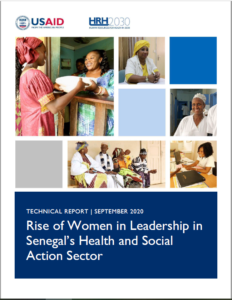30 Sep Rise of Women in Leadership in Senegal’s Health and Social Action Sector
Between 2000 and 2019, there were dramatic increases in the proportion of women in leadership positions within Senegal’s Ministry of Health and Social Action, leaping from almost zero in the decade prior to 52 percent in 2016, following the enactment of a national gender policy and the appointment of a female minister of health. What were the effective interventions that contributed to the rise of women in leadership positions? Little research has been done in this area.
To address this, HRH2030 led a study that developed a sex-disaggregated leadership inventory to determine if female participation in leadership positions in the health and social services sectors increased after public or private sector institutions took specific measures or initiatives. The study also assessed the remaining gender gap, and the existing barriers and biases that contribute to this gap.
The study found an average 3 percent annual increase in the number of women in leadership roles over the last 20 years—a major accomplishment for Senegal’s health and social sectors. A part of this success story is concerted efforts to implement parity policies and gender strategies that encourage female leadership and gender equity. However, it also noted that the achievement is fragile, with a declining rate across all levels over the last two years of the study (2017-2019). There remains room for further improvement to achieve gender balance at all levels of the sector’s leadership. This requires accurately monitoring trends in female representation in leadership positions and catching negative trends as early as possible to take appropriate and corrective action. In addition, women in certain public institutions such as referral hospitals and universities are still underrepresented in leadership positions. Institutionalizing gender equity in the sector’s leadership requires continuing attention, advocacy, action, and reform.
Associated Content
Technical Brief: Addressing Women’s Leadership in the Health and Social Service Sectors: Learning from Jordan, Senegal, and Madagascar
Technical Report: Trends of Women in Leadership in Madagascar’s Health and Social Services Sector
Presentation: A Study of Trends and Initiatives in Women’s Leadership in the Health and Social Sector: Progress in Senegal and Madagascar
Overview: Advancing Women’s Leadership in the Health Sector
Blog: Deconstructing Gender Bias in the Health Workforce: Why few women attain leadership positions
Story: Three Questions with Samantha Law: Lifting Up Women in the Name of Health
Report: Evidence-based Interventions to Promote Women in Health Management in Jordan
Country: Senegal
Resource Type: Technical Report
Topic: Women in Leadership
DOWNLOAD






